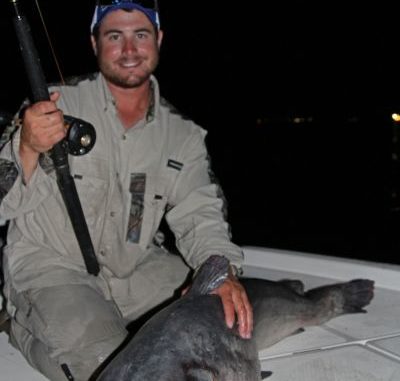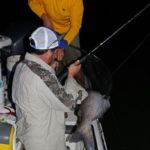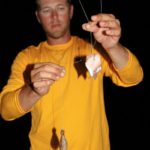
Big cats are an under-utilized angling option on the Mississippi River, but they are plentiful — and they get big. These experts share secrets to finding and putting these bruisers in the boat.
I’ve gotta admit: When Ryan Lambert first showed me the cell phone video, I thought I was looking at a bunch of big bluegill busting bread at the surface.
But then I saw it — an arm entering the frame. This arm was tossing redfish carcasses, heads and all, into the Mississippi River just down the road from Lambert’s Cajun Fishing Adventures lodge in Buras.
“Those are big catfish,” Lambert smiled. “We had them chummed up when we were dumping our carcasses after cleaning our fish one day.”
How big? Well, legal reds have to be at least 16 inches long, and from the video evidence it looked like most of the day’s fish were well past that.
Each time a carcass hit the water, a big mouth would slurp it down in one piece.
Now, when I told Lambert I wanted to shoot one of those big, nasty blue cats, he admitted that he does very little of this type of fishing. Of course, anyone who’s grown up fishing in the South has fiddled with the whiskered ones at some point.
But with a wonderland of saltwater opportunities within easy reach, Delta anglers seldom turn their attention to what is a much-underutilized natural resource.
Well, you might want to rethink that.
Granted, speckled trout are better eats and redfish are much more likely to crush a spinnerbait. But if a roll-up-your-sleeves, bare-knuckles street fight sounds like an intriguing angling option, read on.
On my second night at Lambert’s lodge, my host asked guides Ross Montet and Cody Obiol to see if they could rustle up one of those river blues for a few glamor shots.
Both had wrestled with these slimy opponents before and, while they noted that the marsh mix gets the majority of their guiding time, they felt reasonably confident they could get a big blue cat to play.
(Spoiler alert: Mission more than accomplished.)
Now there’s no way to be certain, but it’s likely we had seen these fish on sonar earlier in the day while trying out some new Humminbird equipment. Electronics guru Doug Vahrenberg demonstrated how the combination of side-scanning sonar and 2D sonar can facilitate the location of likely catfish haunts, while identifying bait schools and catfish holding at various depths.
“I think the stereotype of a catfisherman is a guy sitting on the bank and the stereotype of a catfish is a fish laying on the bottom,” Vahrenberg said. “But I’ve seen the myth change. I’ve seen how cats (occasionally) suspend. What’s interesting to me is how technical the industry has become. It’s become very high tech.”
As luck would have it, some of our best marks were sitting within shouting distance of the launch ramp off Highway 11 just north of Lambert’s place.
Launching around 8:30 p.m., Montet idled out to the first ledge before the main river channel drop-off, and within 30 minutes he and Obiol were holding up a 40 pounder.
With plenty of bait and interest remaining, the anglers reset their rods, and it wasn’t 10 minutes before Montet got another good arm stretching — this time, to the tune of a solid 60-pound blue that flopped halfway out of the Frabill tournament net.
Is it always that quick and convenient? Not necessarily. But you’ll rarely need to run far to find one of these beasts and, properly positioned, it doesn’t take long to get one interested in an easy meal.
A brief tutorial to help you find success with these bruisers.
When and where
Catfish pretty much eat when food avails, so daytime or night can produce well.
As Montet noted, the things to look for are the habitat, something to break the current and the food sources. Blue cats won’t pass up the easy meal of cleaning-table carcasses or whatever the river delivers, but baitfish schools will not go undetected or unmolested.
Obiol said he often finds catfish on the outside edges of current seams where the river outlets into the marsh. In these locations, he’ll cast his bait into the eddies and let it drift out into the still water.
On the river, prominent rocks, ledges and sunken barges offer attractive catfish habitat. Montet pointed out that seasonal river extremes create dynamics meriting consideration.
“When the river is low, the saltwater wedge pushes farther up, and the catfish will move upriver to stay in the freshwater that they prefer,” Montet said. “When the river is really high, the current can be too strong to properly anchor and present your baits.
“You want a certain amount of current to wash food down to them. Catfish are just like us; they like an easy meal and they don’t want to have to work too hard for it.”
When searching for cats, Humminbird’s Doug Vahrenberg suggested setting the sonar beams at 100 feet because it makes for easy math when identifying fish location: Half is 50 feet, a quarter is 25, etc.
He also suggested adjust your sonar unit’s color palate for optimal night viewing; he likes green for dark hours.
Chum and bait
With catfish, it’s hard to find something they won’t bite, but stick with the common baitfish (pogies and mullet) and anything from the cleaning table.
For our trip, Montet and Obiol loaded four laundry baskets packed with trout and redfish carcasses on the back deck of Obiol’s bay boat. This provided an ample chum source, while belly strips made for catfish-pleasing bait.
A point to consider: It might be tempting to think catfish that can slurp down an entire trout or redfish carcass can do the same with a baited hook. However, to prevent gut hooking and to simply allow sufficient space for the hook to penetrate the fish’s mouth, keep the bait size modest. Montet did just fine with 2-inch trout belly strips.
“You chum until you get a bite going. If you can’t get a bite within 15 to 30 minutes, it’s time to leave,” Montet said. “Now, if you know there’s a fish there — maybe you saw him on your sonar — you might want to give it a little longer and figure they’re going to turn on eventually.
“Enough chum will get them feeding. And even the fish farther downriver, it will get them to come in and get them in a frenzy.”
Tackle and bait
Montet said your basic snapper rigs with 80- to 100-pound braided line on conventional gear works just fine for these river blues. His preference is an Abu Garcia 7000 baitcaster on a 7- to 7 ½-foot rod.
He favors braid because the sensitivity helps him detect light “pick-up” bites. Moreover, braid’s zero stretch enables him get a good hook set from any distance.
Effective rigging styles vary from a Carolina rig to a fish-finder to a knocker rig.
Montet keeps it simple, with a beefed up, modified dropshot.
He starts by affixing a 6- to 8-ounce bell sinker to the terminal end with a Palomar knot, and then he forms a dropper loop about 5 feet up the line (the exact spacing is relevant to fish positioning and bottom structure).
Pushing the loop through the hook eye, he’ll pass the it over the entire hook and cinch the loop against the line on the backside of the eye. This attachment strategy allows for quick hook change.
“(You d)on’t necessarily need a leader, so you don’t have to use a fluoro leader,” Montet said. “The river water is not that clean and catfish are more geared toward smell, so they don’t usually spook away from braided line.”
And the strength of the braid comes in handy because Mississippi River blue cats are on the hardy side, Montet said:
“I’d have to say they’re a little stronger (than lake fish) because they have to fight the current,” he said. “You get more fight out of them.”
When fighting one of these brutes, Montet advised anglers to keep their rod tips up as high as possible, maintain constant pressure and just know that overcoming these heavy-handed opponents is just a matter of outlasting their resolve.
What you feel isn’t just catfish — it’s also a lot of river, so persevere and prevail.
“You’re not fighting just the fish, you’re fighting the current, too,” Montet said. “It’s like trying to pull up a 5-gallon bucket. Basically, you have to tell them who’s boss.”






